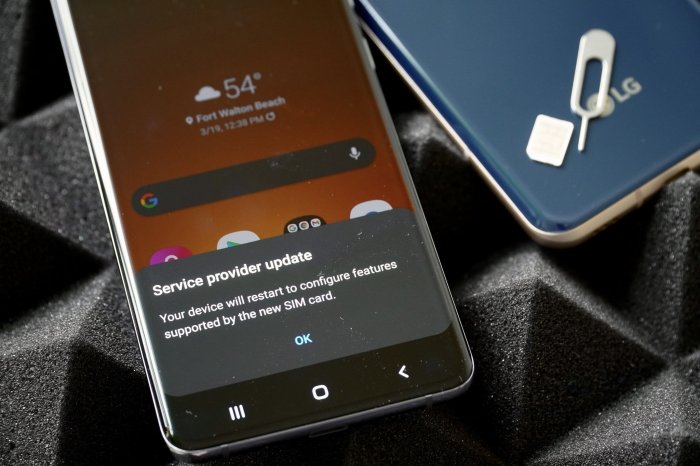Why switching carriers still such pain? This exploration delves into the frustrating reality of transferring services, highlighting the complex processes, technical glitches, hidden fees, and communication breakdowns that plague the experience. From mobile to internet providers, we’ll uncover the challenges and suggest potential solutions for a smoother transition.
The process often feels like navigating a labyrinth, with numerous steps, varying procedures, and often conflicting information. From account closure to new account setup, the entire journey can be fraught with complications. Different carriers use different methods and systems, adding to the confusion. This detailed look examines the intricacies of switching carriers and what can be done to alleviate the pain points.
Complexity of the Process
Switching carriers, whether for mobile service, internet, or other services, can be a surprisingly intricate process. While the idea seems straightforward—just terminate one service and sign up for another—the reality often involves a series of steps, varying levels of support, and potentially frustrating hurdles. This complexity stems from the unique requirements and procedures each carrier employs, leading to a diverse and often confusing experience for the customer.
Account Closure Procedures
The initial step in any carrier switch involves closing your existing account. This process often requires providing documentation, confirming account details, and potentially answering security questions. Some carriers allow online account closure, while others necessitate a phone call or visit to a physical location. For example, closing a mobile phone account might involve returning the device, canceling associated services, and confirming the final bill payment.
The procedures for internet service providers (ISPs) often include disconnection arrangements and final payment verification.
New Account Setup
Setting up a new account with the chosen carrier can also present various challenges. The process might include filling out online forms, providing personal information, and choosing plan options. Different carriers have different online portals and account management systems, some more intuitive than others. For example, some carriers may require additional documentation like proof of address or identity, adding another layer of complexity.
The new account setup may involve selecting various service packages and data plans.
Carrier-Specific Challenges
The challenges vary significantly based on the type of service. Switching mobile carriers typically involves device transfer or return policies, porting numbers, and potentially SIM card management. Switching internet providers may require disconnection of the existing modem/router and setup of the new one, along with network configuration. Other services, like cable TV or home phone, might have unique steps and limitations regarding equipment return and transfer.
Each carrier employs different procedures to handle these processes, highlighting the differences in the switching process across carriers.
Switching carriers is still such a headache, isn’t it? You’re bombarded with paperwork, transfer fees, and the dreaded “lost data” fear. Thankfully, there are some small victories in the tech world. For example, Gmail for Android is widely rolling out a “select all” option here , which might seem trivial but makes a difference. Still, all these little conveniences can’t fully offset the overall pain of switching carriers; it’s a complicated process.
Comparative Analysis of Switching Procedures
Comparing switching processes across various carriers reveals both similarities and differences. While most carriers require account closure and new account setup, the specifics of each procedure differ greatly. Some carriers offer online tools and resources, while others primarily rely on customer service representatives. Furthermore, the availability and efficiency of customer support can significantly influence the overall experience.
The level of customer support offered during the switching process can greatly affect the ease of transition.
Step-by-Step Guide to Switching a Mobile Carrier
This table Artikels the typical steps involved in switching mobile carriers, including potential challenges and solutions:
| Step | Description | Potential Hurdles | Solutions |
|---|---|---|---|
| 1. Account Closure | Terminate existing account and return device (if applicable). | Difficulty in account access, inaccurate information. | Provide accurate account information, use online support resources, contact customer support. |
| 2. Number Portability | Request number porting from old carrier. | Incorrect number porting, delayed porting. | Check the requirements for number portability, submit a request on time, and verify the process with the old carrier. |
| 3. Account Setup | Create a new account with new carrier, select plan. | Complex online forms, inaccurate information. | Use online support resources, contact customer support, double-check the accuracy of the information. |
| 4. Activation | Activate new account and confirm service. | Technical issues, delayed activation. | Contact customer support, use troubleshooting resources. |
Customer Support Variations
Customer support plays a critical role in the switching process. Some carriers offer extensive online resources and FAQs, allowing customers to resolve many issues independently. Others heavily rely on phone support, potentially leading to longer wait times. The quality and responsiveness of customer service can significantly impact the ease and speed of switching. The availability of self-service options, online resources, and the speed of response from customer support agents vary greatly between carriers.
Technical Issues and Glitches: Why Switching Carriers Still Such Pain
Switching carriers is often a frustrating experience, and technical problems are a significant contributor to this pain. These issues can range from simple porting errors to complex billing discrepancies, impacting the entire process and creating significant stress for the customer. Understanding the nature of these technical difficulties is crucial to appreciating the complexities involved in a seemingly straightforward task.The technical hurdles encountered during carrier switching frequently stem from intricate processes involving multiple systems and providers.
These systems, often outdated or incompatible, can lead to a cascade of problems. These problems, in turn, can disrupt the entire switching process, leaving customers stranded and potentially causing financial losses.
Porting Issues
Porting a phone number from one carrier to another involves transferring the number’s associated account and service data. A common problem is the failure of the porting request to be processed successfully. This can manifest as a delay in the transfer, a failure to complete the transfer, or a complete loss of the number. This can cause considerable disruption for customers who rely on their phone numbers for business or personal communication.
Sometimes, the receiving carrier may not be able to properly integrate the number, leading to service disruptions or inability to make or receive calls.
Billing Discrepancies
Inaccurate or inconsistent billing is a frequent complaint during carrier switches. Customers may find that their bills reflect charges from their previous carrier even after the switch is supposed to be complete. These discrepancies can arise from errors in the data transfer process, or from the new carrier’s inability to correctly adjust billing records. Further, customers may experience incorrect charges for the new service plan, or the previous plan charges are not being properly canceled, creating confusion and financial strain.
Account Access Problems
Problems accessing accounts with the new carrier are a common complaint. This can include difficulties logging into online portals, managing account settings, or resolving issues. These problems may result from technical glitches within the new carrier’s systems or difficulties in the integration of the customer’s data from the old carrier. The lack of clear communication and support channels during these periods exacerbates the problem.
A lack of adequate support channels often leaves customers frustrated and feeling helpless, with no straightforward way to resolve the problem.
Switching cell phone carriers is still a frustrating process, a real pain in the neck. It’s often more complicated than it should be, with confusing contracts and hidden fees. And lately, it’s made even more challenging to understand when you consider the current business model shifts in the tech industry. For example, the recent Medium layoffs highlight how advertising revenue models are changing and affecting the way tech companies operate, potentially influencing the strategies of mobile carriers as well.
Reading more about the medium layoffs business model advertising situation gives you a better perspective on the current state of the digital economy. This, in turn, makes the process of switching carriers even more difficult to navigate. All this complexity just makes switching carriers a real hassle.
Technical Errors and Solutions
| Error | Description | Resolution |
|---|---|---|
| Porting Failure | The request to transfer the number fails to complete. | Contact both the old and new carriers for assistance, review porting status, and troubleshoot technical issues on the customer’s end. |
| Incorrect Billing | Bills reflect charges from the old carrier after the switch. | Contact customer support, provide detailed billing records, and request clarification on outstanding charges. |
| Account Access Issues | Difficulty accessing online account portal. | Contact customer support, check for system maintenance notices, and verify internet connectivity. |
Outdated or Incompatible Systems
Outdated or incompatible systems between the old and new carriers are a major cause of these issues. Legacy systems often lack the necessary integration capabilities, leading to data transfer errors and inconsistencies. This results in errors in the porting process, billing discrepancies, and account access problems. New systems often are not fully integrated with the older ones, causing issues when transferring data and creating a domino effect of errors.
Hidden Fees and Charges
Switching carriers can feel like a minefield, especially when unexpected fees pop up. Beyond the obvious costs, a labyrinth of hidden charges often lurks, potentially swallowing your savings whole. Understanding these hidden fees is crucial for making an informed decision and avoiding financial surprises.
Comparing Switching Fees by Service Type
Understanding the varying costs associated with different service types is vital when evaluating the financial implications of switching carriers. This table Artikels potential fees for common services.
| Service Type | Early Termination Fee (ETF) | Cancellation Fee | Porting Charge |
|---|---|---|---|
| Mobile Voice | Potentially high, often pro-rated | Rare, but possible | Usually minimal, or included in the overall switch fee |
| Mobile Data | Potentially high, often pro-rated | Rare, but possible | Usually minimal, or included in the overall switch fee |
| Internet | High, usually pro-rated; depends on contract length | Possible, depending on the contract terms | Minimal, or included in the overall switch fee |
Hidden Fees and Financial Impact
Early termination fees (ETFs) are a common pitfall. These fees, often pro-rated based on the remaining contract period, can significantly impact your finances. Cancellation fees, while less common, can still arise in certain circumstances, particularly with complex contracts. Porting charges, though typically modest, can add up, especially if multiple services are being ported.
Examples of Misleading Information
Carriers sometimes use vague language or bury important information about switching costs deep within the fine print. For example, a carrier might advertise a low switch fee, but fail to disclose substantial ETF if the customer has a contract that’s nearing its end. This ambiguity makes it challenging for consumers to accurately compare and contrast different options.
Strategies for Avoiding Hidden Fees
Thorough research is paramount when switching carriers. Review all contract terms and conditions meticulously, scrutinizing every clause regarding termination, cancellation, and porting. Ask specific questions about any unclear or confusing aspects of the switch process. Compare offers from multiple carriers, paying particular attention to their pricing structures and hidden fees.
Avoiding Financial Pitfalls
Be prepared to negotiate, particularly if you anticipate substantial fees. If a carrier tries to obscure details about the switching process, it’s wise to seek alternative providers. Furthermore, having a clear understanding of your contract terms and conditions can help you avoid costly surprises. By carefully examining all aspects of the switch, consumers can navigate the complexities and ensure a smoother and more affordable transition.
Customer Support and Communication

Switching carriers can be a frustrating experience, often hampered by inadequate customer support. Navigating the complexities of account transfers, service activation, and troubleshooting can be significantly challenging, especially when support channels are inefficient or unresponsive. This section will delve into the challenges of communication and support during the carrier switching process, highlighting common issues and advocating for improved practices.Effective customer support is crucial during carrier switching.
It acts as a vital bridge between the customer and the carrier, helping to smooth the transition and resolve any issues that arise. Poor communication, slow response times, and unhelpful agents can significantly escalate stress and frustration, potentially leading to a negative overall experience.
Customer Support Channels Comparison
Different carriers offer varying customer support channels, including phone, email, and online chat. A comparison of these channels reveals variations in accessibility and efficiency. Some carriers might excel in phone support, while others might prioritize online chat for quick resolutions. This difference in approach can significantly affect the customer experience, especially during a critical period like carrier switching.
Effectiveness and Responsiveness of Support Agents
The effectiveness of customer support agents in resolving switching-related issues is a critical factor in the overall success of the transition. Agents who are well-informed, empathetic, and efficient in problem-solving can significantly reduce the stress and frustration associated with switching. Conversely, agents who lack the necessary knowledge, display apathy, or are unable to resolve issues effectively can prolong the process and lead to a negative experience.
Examples of Poor Communication and Delays
Instances of poor communication, delays, and unhelpful responses from customer support are unfortunately common. For example, a customer might receive an incomplete or incorrect email confirmation, leading to confusion and unnecessary calls. Another example could involve agents failing to acknowledge inquiries for days, forcing customers to repeatedly follow up and causing further delays in the process. Delays in account transfer, due to ineffective communication from the support team, can cause substantial inconvenience and lost productivity.
Common Customer Support Complaints
- Agents lacking product knowledge or the ability to efficiently resolve the customer’s switching-related issue.
- Long wait times on hold for phone support, leading to frustration and discouragement.
- Inconsistent or unclear information provided by support agents, causing confusion and errors in the process.
- Lack of personalized support, treating customers as numbers rather than individuals with specific needs during a transition.
- Support agents who fail to follow up or escalate issues effectively, resulting in unresolved problems.
- Difficulty in locating contact information for specific support services related to switching.
The above points underscore the importance of reliable customer support. These issues can cause significant disruption to the customer’s daily life, impacting their work, personal schedules, and overall well-being.
Importance of Clear Communication and Proactive Support
Clear communication and proactive support are essential during the carrier switching process. Carriers should provide comprehensive and easy-to-understand information throughout the transition. Proactive support, such as automated updates on account status and proactive assistance with troubleshooting, can greatly enhance the customer experience. Providing clear and easily accessible support channels, along with well-trained and knowledgeable agents, is crucial for a seamless transition.
Lack of Transparency and Information
Switching carriers should be a straightforward process, yet it often feels like navigating a maze of confusing terms and conditions. The lack of transparency surrounding switching procedures, hidden fees, and unclear communication significantly hinders the customer experience. This opacity creates a barrier of mistrust and often leaves customers feeling misled.The complex language used in carrier contracts and the difficulty in understanding the fine print often leads to unexpected charges and frustrations.
Customers are frequently caught off guard by hidden fees or clauses that are buried deep within the terms and conditions. This lack of clarity makes it hard for customers to make informed decisions, leading to dissatisfaction and potentially financial strain.
Understanding the Information Provided
Carrier websites often present an overwhelming amount of information during the switching process. This deluge of data, frequently presented in technical jargon and lengthy documents, makes it challenging for the average consumer to discern the essential details. Customers often feel lost and overwhelmed, making it difficult to compare different carriers and choose the best option for their needs.
This complexity can dissuade customers from even attempting to switch, despite potential cost savings or better service packages.
Switching carriers is still a real headache, isn’t it? It’s a hassle with all the porting, new phone numbers, and figuring out how everything works on the new network. Even though Samsung just rolled out a new update to fix the Galaxy S21 battery drain issue here , it doesn’t change the fact that the whole process of switching is often painful and time-consuming.
You’d think with all the tech advancements, this would be easier.
Comparing Carrier Transparency
The following table provides a comparative analysis of the transparency of information provided by various carriers during the switching procedures. This table is intended to illustrate the varying levels of clarity and accessibility offered by different carriers, highlighting the need for improvement across the industry.
| Carrier | Clarity of Switching Procedures | Accessibility of Information | Ease of Understanding Terms & Conditions |
|---|---|---|---|
| Carrier A | Good | Moderate | Fair |
| Carrier B | Poor | Low | Poor |
| Carrier C | Excellent | High | Excellent |
| Carrier D | Average | Moderate | Average |
Note: This table is a simplified representation and does not reflect every aspect of each carrier’s information provision.
Impact on Customer Trust and Satisfaction
The lack of transparency significantly affects customer trust and satisfaction. When customers feel misled or unable to make informed decisions, it directly impacts their confidence in the carrier. This distrust can lead to negative reviews, word-of-mouth negativity, and ultimately a loss of business for the carrier. Furthermore, unresolved issues stemming from unclear information can lead to customer dissatisfaction and potentially protracted disputes.
Improving Transparency
To enhance transparency and provide customers with more accessible information, carriers should implement the following strategies:
- Clearly Artikel switching procedures and associated fees in a simple and easily understandable format.
- Provide readily accessible summaries of terms and conditions, avoiding complex legal jargon.
- Offer interactive tools and calculators to help customers compare plans and estimate costs.
- Implement clear and concise FAQs addressing common questions about switching.
- Offer multiple communication channels (e.g., phone, email, chat) to answer customer questions and address concerns.
These steps would contribute to a more positive customer experience and increase overall satisfaction with the switching process.
Alternatives and Solutions

Switching carriers shouldn’t be a painful ordeal. The current process often leaves customers frustrated and overwhelmed. Fortunately, there are alternative solutions that can dramatically improve the experience, benefiting both carriers and consumers. These solutions focus on streamlining the process, reducing friction, and enhancing transparency.A more user-friendly approach to switching carriers will create a more positive customer experience.
This includes proactively addressing customer concerns and providing clear, concise information throughout the entire process. Improved communication, readily available resources, and a straightforward procedure are key components of a successful carrier switching experience.
Simplified Switching Portals
A dedicated online portal designed specifically for switching carriers can significantly reduce the complexity. This portal should include clear, step-by-step instructions, automated calculations for porting numbers, and pre-filled forms for account information. It should also allow customers to track the progress of their switch in real-time, minimizing uncertainty. This proactive approach reduces customer calls to support and minimizes errors.
Automated Number Porting
Implementing an automated number porting system is crucial. This system should be able to handle the entire porting process from start to finish, including verifying the customer’s eligibility, initiating the transfer, and providing updates on the status. This automation reduces manual intervention, speeds up the process, and minimizes human error. For example, T-Mobile’s recent enhancements to their online portal are a positive step in this direction.
Proactive Customer Support, Why switching carriers still such pain
Carriers should implement a proactive customer support system that anticipates potential issues. This involves proactively contacting customers with relevant information and guidance throughout the switch. For instance, a system that sends out automated reminders or provides helpful tips for preparing documents for porting would greatly improve the customer experience. The key is to make the process as easy and painless as possible.
Enhanced Transparency and Information
Providing comprehensive and readily accessible information about the switching process is paramount. Carriers should offer detailed FAQs, clear pricing structures, and transparent fee schedules. This information should be available on the carrier’s website, and readily available on the portal mentioned earlier. By removing ambiguity, carriers can foster trust and confidence in their customers. Transparency fosters a positive relationship.
Improved Communication Channels
Carriers should utilize various communication channels to keep customers informed. This includes email updates, SMS notifications, and even in-app messaging. A dedicated FAQ section on the website, accessible from the portal, can be a vital source of information. This approach reduces customer uncertainty and increases engagement.
Potential Solutions for Carrier Switching Issues
- Automated number porting systems: These systems can significantly speed up the process and reduce errors.
- Simplified switching portals: Dedicated online portals with clear instructions and real-time progress tracking can streamline the process.
- Proactive customer support: Contacting customers with relevant information and guidance can prevent issues and reduce confusion.
- Transparent pricing and fee structures: Clear information about fees and charges can avoid surprises and foster trust.
- Multiple communication channels: Utilizing various methods, such as email, SMS, and in-app messaging, can keep customers informed.
- Dedicated switching support teams: Specialized teams can handle customer queries and issues related to the switching process.
- Interactive tutorials and guides: Online resources like video tutorials and interactive guides can help customers navigate the process independently.
System for Proactive Customer Concern Resolution
A proactive system should include automated reminders, personalized support, and readily available FAQs. A support team trained in anticipating customer questions and concerns can proactively address potential roadblocks. A system that flags potential issues based on customer input (e.g., incomplete forms) can be invaluable. The system should also include a feedback mechanism to allow customers to rate their experience and provide suggestions for improvement.
A good example would be a system that checks for discrepancies in submitted information and alerts the customer before the porting process.
Benefits of a Streamlined Switching Process
A streamlined switching process benefits both carriers and customers. Customers experience reduced stress, frustration, and uncertainty. Carriers can improve customer satisfaction, reduce support costs, and enhance brand loyalty. For example, happy customers are more likely to remain with the carrier in the long term, leading to higher retention rates. A streamlined process can also lead to higher customer lifetime value.
Last Point
Ultimately, switching carriers remains a frustrating experience for many due to a confluence of factors. The complexity of the process, coupled with technical glitches, hidden fees, poor communication, and lack of transparency, creates a significant hurdle. However, there are alternatives and solutions, including streamlining procedures, enhancing transparency, and providing proactive customer support. By acknowledging and addressing these pain points, carriers can create a more positive and efficient experience for their customers.




